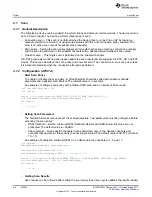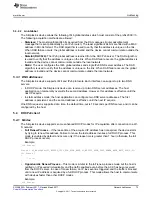
Introduction
70
SWRU455A – February 2017 – Revised March 2017
Copyright © 2017, Texas Instruments Incorporated
Network Addresses
5.1
Introduction
The SimpleLink Wi-Fi device has a built-in integrated network stack that offloads network activities from
the host MCU, and decreases its code size and memory consumption. The network stack supports IPv4,
IPv6, TCP, UDP, SSL, TLS, and a suite of network applications that are required by IoT and internet-
enabled devices. This chapter provides the basic information and feature list of this network stack.
The host requires integrating only a small software driver, which provides a simple and slim API set for the
networking activities. The traffic APIs performed by the socket layer adhere to the Linux variant of the
Berkeley Sockets (BSD).
describes this layer in more detail.
The SimpleLink device implements a dual network stack, which allows access to IPv4 and IPv6 networks
simultaneously. IPv4 is enabled by default in all Wi-Fi modes: STA, AP, and Wi-Fi Direct. IPv6 is
supported only in STA mode, disabled by default, and can be enabled if needed.
5.2
Key Features
describes the major features of this network stack.
Table 5-1. Key Features
Key Features
Description
IP protocols
IPv4, IPv6
IP addressing
LLA, DHCPv4, DHCPv6, static, stateless
Cross layer
DAD, NDP, ARP, ICMPv4, ICMPv6
Application
DNS server, DNS client, DHCP server
5.3
Addressing
The SimpleLink Wi-Fi device supports multiple IP address-acquiring methods. For Wi-Fi station and Wi-Fi
Direct client modes, IP acquiring processes start after successful Wi-Fi connection. For AP and Wi-Fi
Direct GO, the IP address is static and predefined. Changing addressing configuration requires device
reset, as shown in
Table 5-2. Addressing
Wi-Fi Station
Wi-Fi AP
Wi-Fi Direct
IPv4
Always enabled
Static
Client – like station
Group Owner – Like AP
One IP address:
• DHCP
• LLA
• Static
IPv6
Disabled (default)
Not supported
Not supported
Up to two IP addresses:
• Local (mandatory):
o
Stateless – Link-Local
Address (FE80::/64)
o
Statefull (DHCPv6)
o
Static
• Global (optionally):
o
Stateless
o
Statefull (DHCPv6)
o
Static















































